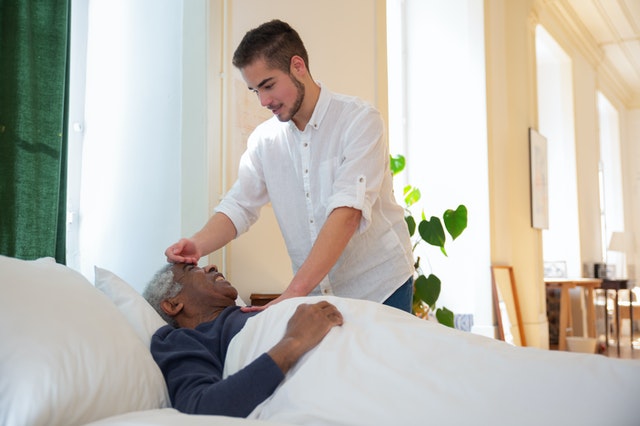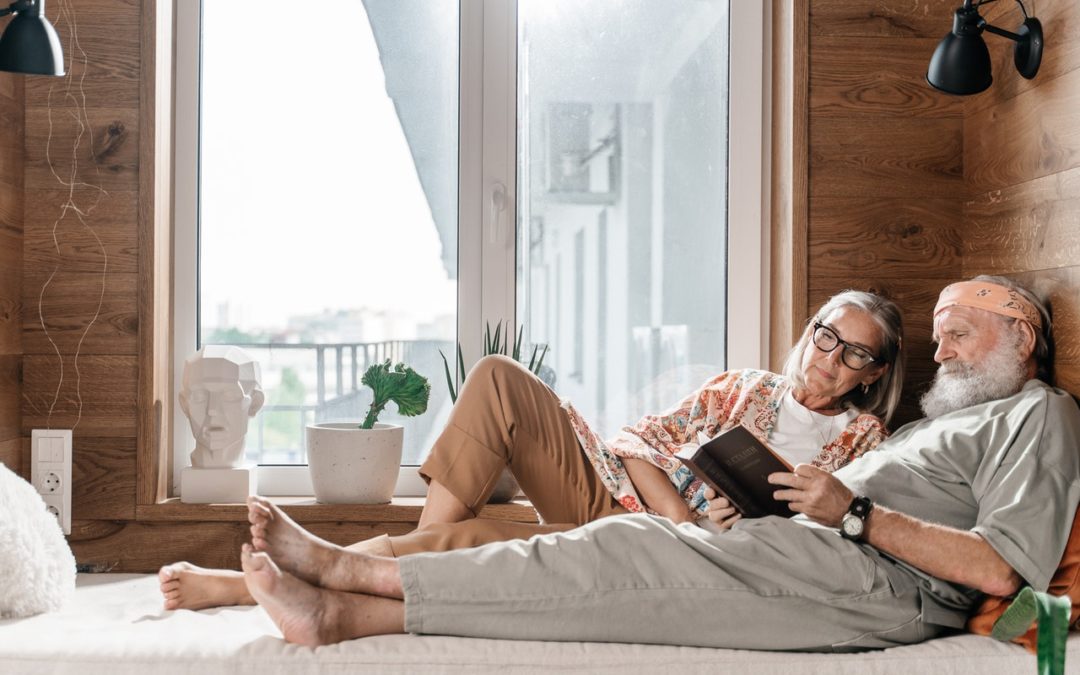As we get older, it can become more difficult to achieve certain daily tasks without a bit of help. Many seniors prefer to stay at home or age in place rather than going into a nursing home or an assisted living facility. In fact, a recent study of adults over the age of 50 showed that almost 90-percent of Americans would prefer to age in place. If you or a loved one are interested in achieving this, there are some things you can do to make your home safer and more accommodating. Read on to learn more about aging in place and how you can make some retrofits for you or an elderly loved one to continue living at home.
What Is Aging in Place?
The term “aging in place” refers to seniors and older adults who prefer to maintain their independence while living at home. The opportunity to age in place allows seniors to maintain some form of independence and familiarity. Many don’t want to leave their neighborhoods or communities, while others simply have a deep attachment to their homes. Rather than enrolling in residential or group care, aging in place allows older people to remain at home, regardless of their age or condition. While it’s not always possible to age in place forever, most people agree that it’s less expensive than going to an assisted living facility and promotes better mental health and overall well-being.
How to Grow Older at Home

You can do some things to prepare for aging in place and for growing older while remaining at home. Here are some tips to help you or a loved one prepare:
- Start by performing a safety audit on your home to ensure that it’s safe. You can find several checklists online that will provide you with simple tips to ensure that you set up every room for senior safety.
- Keep on top of your health by attending regular doctor visits and following a healthy diet and lifestyle. The more you focus on your health now, the longer you’ll be able to enjoy aging in place.
- Set up a plan to make sure you have transportation when it’s needed. Whether you have a family member take you to run errands or find neighbors you can count on, this is important to find, so you’re able to get around later on when you’re unable to drive on your own.
- Consider getting long-term care insurance, which provides for things that Medicare won’t. This insurance will help cover having a caregiver in your home so that you can get help when it’s needed.
- Focus on getting your home ready for aging in place now so that you can enjoy it during your golden years.
Home Renovations to Age in Place
You can do some renovations and retrofits for the elderly to ensure that you or your loved one’s home is safe. Here are some ideas and tips to help you get ready for your new senior-safe home.
General household: Declutter your home and move furniture to create a clear walking path that is obstacle-free in every room. Make sure all light switches are easy to reach and install rocker switches for easy use. Light up any dark areas of the home with night lights, rope lighting, and task lights. Secure loose carpeting and area rugs, ensuring all corners and edges are flush to the floor. Get rid of any cables and cords running across floors and walkways, and put wiring behind furniture or attach it to the walls with clips. Make sure all of your smoke alarms and CO2 detectors are in good working order and that batteries are changed regularly. If a family member uses a wheelchair, it is a good idea to install a stairlift if they live in a two-story house.
Entryway: Make sure there’s a clear path from the driveway or walkway to the front door, and if it is necessary have your doors widened. Look for cracks or uneven surfaces and repair them to create a level surface. Trim or remove any landscaping that’s blocking walkways so you have enough room for a walker or wheelchair. Install sturdy handrails on both sides of your front entryway steps if you have them. Consider installing a ramp or getting a portable wheelchair ramp to make getting in and out of the home more accessible. Check to ensure that the locks are secure and easy to use and that there’s a peephole installed in the door. Check entryway lighting to ensure it’s bright enough and install dusk-to-dawn lights, so they turn on automatically.
Kitchen: Remove items on high shelves and place them on top of the counters or inside low-level cabinets. Change knobs on drawers and cabinets to pulls or levers. Inspect all appliances to make sure they’re in good condition. All controls and knobs should be located near the front and clearly labeled. Only use small appliances that include an automatic shutoff feature. Use dark-colored dishes and cookware that will stand out on the counters, so they’re easier to see. A “lazy Susan” can help you access items that are further back inside shelves or cabinets.
Bathroom: Use a shower chair or shower bench and install a handheld showerhead for easier bathing, emergency buttons are normally waterproof and safe to wear in the shower, but if that is not the case, you can install a wall-mounted emergency button in the shower and near the toilet; equip your bathroom with a raised toilet seat to help prevent slips and falls. Ensure that there’s ample overhead lighting in the bathroom over the tub and sink, you may also want to get a walk-in tub or have a roll-in shower. Install anti-scald devices on faucets and set the hot water heater to 120 degrees Fahrenheit or lower. Make sure you clearly label all taps for hot and cold. Use slip-resistant materials on the floors like tile or vinyl with grout lines to provide more traction. Install grab bars in the tub or shower and around the toilet seat, also, add non-skid decals to any slippery areas.
Bedroom: Check to ensure that your bed is at a safe height. Seniors should be able to sit on the edge with their knees bent and feet flat on the floor. If not, add risers to the bedframe to give it more height. Beds that are too high can be lowered by removing the box spring or adding a thinner, lower-profile box spring. Add some bed rails or a pull-up device under the mattress to make sitting up easier. Always keep a flashlight with fresh batteries in the nightstand to help you see and add nightlights to outlets in the bedroom. Consider a bedside commode if you get up to frequently use the bathroom during the night.
Specific modifications for the hard of hearing and visually impaired
Many seniors are hearing or visually impaired, so here are a few special modifications to consider for aging in place:
Hard of hearing: Install a doorbell with a flashing light, so the hard of hearing are alerted whenever someone approaches the home. Ensure all smoke alarms have flashing lights to help alert seniors who are hard of hearing in the event of fire or smoke. When setting a kitchen timer, use your smartphone and have it set to vibrate when the time is up. Ask about modifications to landline phones and appliances that can help make it easier for those who have difficulty hearing.
Visually impaired: Remove all possible trip hazards and modify lighting to be brighter by installing more brilliant lightbulbs throughout the home. Use dark-colored dishes in the kitchen, so they’re easier to see. Avoid having “busy” area rugs or flooring that can make it difficult to distinguish between furniture and the floor. Add bright, colorful strips across steps and along walkways for easier maneuvering. You can also do this with the doorframes. Mark faucets, food containers, and prescription drugs clearly with large lettering, so they’re easy to see.
Take advantage of Services at Home
Having some help can make aging in place easier. Consider utilizing home care services for errands and other tasks such as assisting you with bathing. Look into local organizations in your area that will be able to help you or a loved one perform various jobs like keeping track of appointments, cooking meals, or physical therapy. You can also sign up for Meals on Wheels to have food delivered or become a member of your local senior center. They may have programs to help seniors get around town and do other tasks.
Hire a Caregiver
Hiring a caregiver provides seniors with the help they need while maintaining their dignity and independence. Research caregivers near you to ensure that you choose a trustworthy and reputable individual and organization. An experienced caregiver can provide companionship, help with health-related issues, and take seniors to run errands like grocery shopping or doctor visits.

Install a Home Security System to Keep You and Your Home Safe
A home security system can help to keep you and your home safe while providing peace of mind. Look for security systems that are easy to use and include things like high-definition indoor/outdoor cameras and monitored alarm systems. A medical alert device is another good thing to have while aging in place. This device allows you to alert your local 911 or a trusted friend or family member in the event of an emergency.
Home Maintenance
Regular home maintenance ensures that your home is safe and in good condition. Consider asking a friend or family member to perform routine maintenance tasks around your house like mowing the lawn, changing light bulbs, and installing retrofits for senior safety. If you don’t have anyone near you, look for reputable contractors in your area that can help with various maintenance tasks.
Home Insurance for Aging in Place
If your home is paid off, you’ll still need home insurance to protect your property and belongings. Ask a local insurance broker about special rates and plans for seniors. This insurance will protect your property in the event of a fire, flood, or other emergency and will reimburse you for any belongings that may need to be replaced.
Use these tips and suggestions for renovations if you or a loved one is planning to age in place. The ability to stay in your own home as you get older is a wonderful way to enjoy your later years comfortably. With a few simple retrofits for the elderly and by taking advantage of at-home senior services, it’s possible to spend your golden years in the comfort of your own home.

